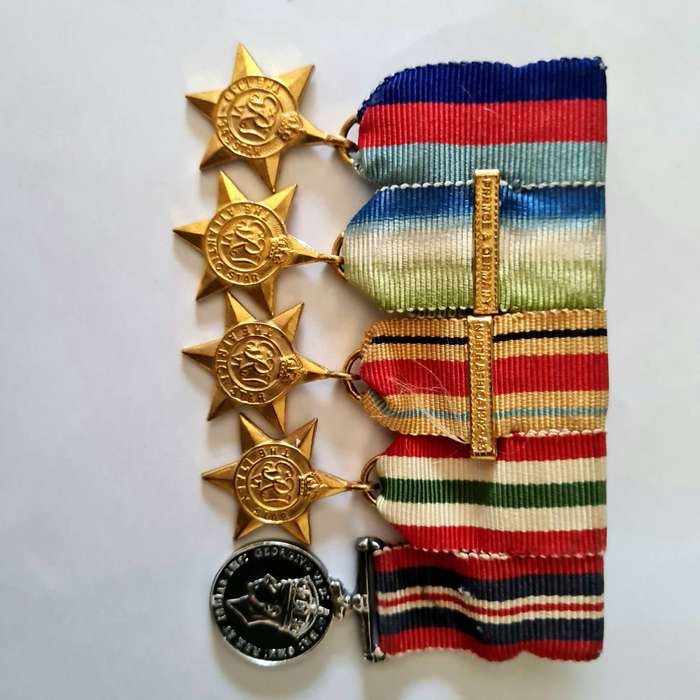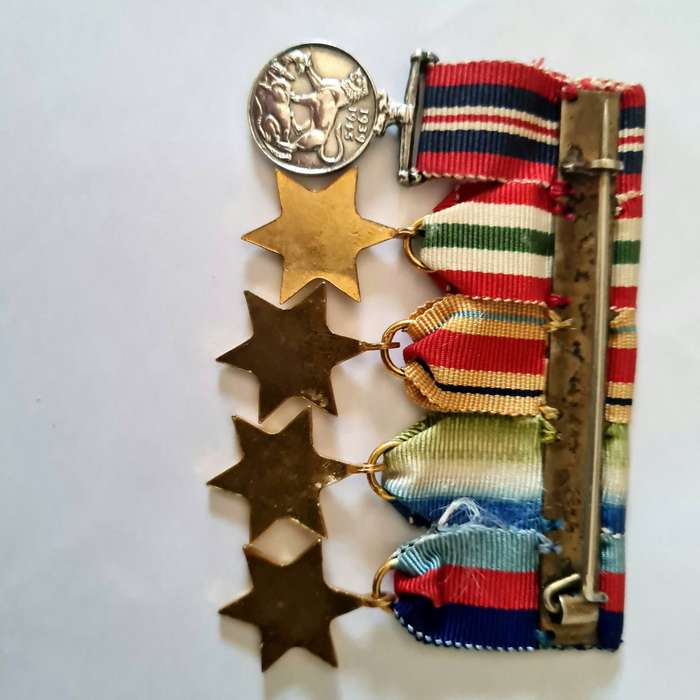



World war 2 medals Royal Marine commando
Check my rate
| Main centres: | 1-3 business days |
| Regional areas: | 3-4 business days |
| Remote areas: | 3-5 business days |




| Main centres: | 1-3 business days |
| Regional areas: | 3-4 business days |
| Remote areas: | 3-5 business days |
These medals represent a set of British campaign medals awarded to a serviceman for their service during World War II. The combination of the 19391945 Star, Africa Star with the "8" clasp, Italy Star, and France and Germany Star indicates that this individual served in multiple theatres of the war, including North Africa, Italy, and Northwest Europe. The Defence Medal signifies that they also served on the home front or in a non-operational role for a significant period.
First Medal (top, star-shaped):
Medal: 19391945 Star
Description: A six-pointed star with the monogram "GRI VI" (George VI) at the center, surmounted by a crown. The ribbon has three vertical stripes: dark blue, red, and light blue.
Significance: Awarded to British and Commonwealth forces for serving in an operational theatre during World War II between September 3, 1939, and September 2, 1945.
Second Medal (second from top, star-shaped):
Medal: Africa Star
Description: A six-pointed star similar to the 1939-1945 Star. The ribbon has a central tan or buff stripe, flanked by a dark blue and a light blue stripe, with a red stripe at the edges.
Significance: Awarded to personnel who served in North Africa between June 10, 1940, and May 12, 1943. The "8" on the ribbon bar indicates the recipient was awarded the 8th Army clasp, signifying service with the British Eighth Army during the campaign.
Third Medal (third from top, star-shaped):
Medal: Italy Star
Description: A six-pointed star with the same "GRI VI" monogram. The ribbon has five vertical stripes: red, white, green, white, and red, representing the colors of the Italian flag.
Significance: Awarded for operational service in Italy, Greece, Yugoslavia, the Dodecanese, or other locations in the Mediterranean from June 11, 1943, to May 8, 1945.
Fourth Medal (fourth from top, star-shaped):
Medal: France and Germany Star
Description: A six-pointed star with the "GRI VI" monogram. The ribbon has five vertical stripes: dark blue, red, light blue, white, and green. The colors represent the national flags of the United Kingdom, France, and the Netherlands. The bar on the ribbon indicates the recipient was also awarded the "8th" Army Clasp for their service in France or Germany.
Significance: Awarded for operational service in France, Belgium, the Netherlands, or Germany from June 6, 1944 (D-Day), to May 8, 1945 (Victory in Europe Day).
Fifth Medal (bottom, circular):
Medal: Defence Medal
Description: A circular silver medal. The obverse side (not visible in the photo) shows the effigy of King George VI. The reverse side (partially visible) shows the motto "FOR KING AND COUNTRY" with a crown. The ribbon has three vertical stripes: green, black, and orange.
Significance: Awarded for three years of non-operational service within the United Kingdom between September 3, 1939, and May 8, 1945, or for shorter periods of service in certain overseas territories.